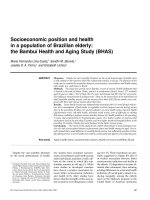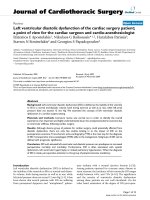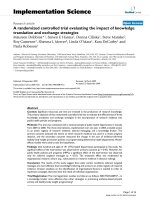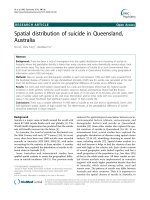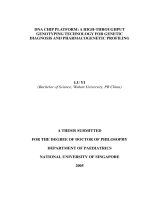Ebook Genetics - A conceptual approad (6/E): Part 2
Bạn đang xem bản rút gọn của tài liệu. Xem và tải ngay bản đầy đủ của tài liệu tại đây (17.36 MB, 1,509 trang )
CHAPTER
15
The Genetic Code and Translation
The spleen, an organ found in the upper abdomen, plays an important role
in defense against infection. Isolated congenital asplenia is an autosomal
dominant condition in which children are born without a spleen.
[Sebastian Kaulitzki/Shutterstock.]
A Child Without a Spleen
T
he spleen is an often underappreciated organ. Brownish in color and
weighing about a third of a pound, it sits in the left upper part of your
abdomen, storing blood and filtering out bacteria and old blood cells. The
spleen is underappreciated because it’s widely believed that you can live
without a spleen. Indeed, many people who lose their spleen to automobile
accidents and other trauma do survive, although they are at increased risk of
infection. But a young child without a spleen is in serious trouble. A small
group of children are born without spleens; these kids are highly susceptible
to life-threatening bacterial infections, and many die in childhood. This rare
disorder, known as isolated congenital asplenia (ICA), is inherited as an
autosomal dominant trait.
Except for the absence of a spleen, children with ICA are unaffected. But
their immune function is severely compromised. When infected with bacteria
that the immune system normally eliminates, these children develop raging
infections that quickly spread throughout the body. Even when treated with
modern antibiotics, they often die.
In 2013, an international team led by scientists from Rockefeller University
discovered the genetic cause of ICA. Using the power of DNA sequencing,
they examined all the coding DNA of 23 individuals with ICA and compared
their DNA sequences with those of 508 individuals with normal spleens.
Statistical analysis pointed to differences in one particular gene that was
associated with ICA, a gene encoding ribosomal protein SA (RPSA). The
RPSA protein is one of the 33 proteins that make up the small subunit of the
ribosome, the organelle responsible for protein synthesis. How a defect in the
RPSA gene results in the absence of a spleen is not known. Diseases such as
ICA, which result from defective ribosomes, are referred to as
ribosomopathies.
Many, but not all, individuals with ICA have mutations in RPSA, indicating
that other genes may also be involved in the disorder. The researchers found
several different types of mutations in RPSA associated with ICA: some
caused premature stop codons, halting translation before a functional protein
could be made; one was a frameshift mutation, a change that alters the way
the mRNA sequence is read during translation; others changed the amino acid
sequence of the RPSA protein.
One interesting but unanswered question is why a defect in RPSA affects
only the spleen. Inherited mutations in RPSA occur in every cell of the body,
and protein synthesis—carried out by ribosomes—is essential for numerous
life processes, yet these mutations affect only the development of the spleen.
Why aren’t other organs altered? Why aren’t numerous physiological
functions affected? Scientists are still studying these important questions.
THINK-PAIR-SHARE
Propose some possible reasons why mutations in the RPSA gene affect only the spleen
and not other tissues where ribosomes carry out translation.
What are some possible reasons that researchers might be interested in identifying the
gene that causes a genetic disease such as ICA? In other words, what benefits might
result from this research?
solated congenital asplenia illustrates the extreme importance of translation,
the process of protein synthesis, which is the focus of this chapter. We
begin by examining the molecular relation between genotype and
phenotype. Next, we study the genetic code—the instructions that specify the
amino acid sequence of a protein—and then examine the mechanism of
translation. Our primary focus is protein synthesis in bacterial cells, but we
also examine some features of this process in eukaryotic cells. At the end of
the chapter, we look at some additional aspects of protein synthesis.
I
15.1 Many Genes Encode Proteins
The first person to suggest the existence of a relation between genotype and
proteins was English physician Archibald Garrod. In 1908, Garrod correctly
proposed that genes encode enzymes, but unfortunately, his theory made little
impression on his contemporaries. Not until the 1940s, when George Beadle
and Edward Tatum examined the genetic basis of biochemical pathways in
the bread mold Neurospora, did the relation between genes and proteins
become widely accepted. Beadle and Tatum’s work helped define the relation
between genotype and phenotype by leading to the one gene, one enzyme
hypothesis, the idea that each gene encodes a separate enzyme.
THINK-PAIR-SHARE Question 1
The One Gene, One Enzyme Hypothesis
Beadle and Tatum used Neurospora to study the biochemical results of
mutations. Neurospora is easy to cultivate in the laboratory, and the main
vegetative part of the fungus is haploid, which allows the effects of otherwise
recessive mutations to be easily observed (Figure 15.1).
Wild-type Neurospora grows on minimal medium, which contains only
inorganic salts, nitrogen, a carbon source such as sucrose, and the vitamin
biotin. The fungus can synthesize all the biological molecules that it needs
from these basic compounds. However, mutations may arise that disrupt
fungal growth by destroying the fungus’s ability to synthesize one or more
essential biological molecules. These nutritionally deficient mutants, termed
auxotrophs (see Chapter 9), cannot grow on minimal medium, but they can
grow on medium that contains the substance that they are no longer able to
synthesize.
Beadle and Tatum first irradiated spores of Neurospora to induce mutations
(Figure 15.2). Then they placed the spores in different culture tubes with
complete medium (medium containing all the biological substances needed
for growth). These spores grew into fungi and produced spores by mitosis.
Next, they transferred spores from each culture to tubes containing minimal
medium. Fungi with auxotrophic mutations did not grow on the minimal
medium, which allowed Beadle and Tatum to identify cultures that possessed
mutations.
Once they had determined that a particular culture had an auxotrophic
mutation, Beadle and Tatum set out to determine the specific effect of the
mutation. They transferred spores of each mutant strain from complete
medium to a series of tubes (see Figure 15.2), each of which contained
minimal medium plus one of a variety of essential biological molecules, such
as an amino acid. If the spores in a tube grew, Beadle and Tatum were able to
identify the added substance as the biological molecule whose synthesis had
been affected by the mutation. For example, an auxotrophic mutant that
would grow only on minimal medium to which arginine had been added must
have possessed a mutation that disrupts the synthesis of arginine.
15.1 Beadle and Tatum used the fungus Neurospora, which has a complex
life cycle, to work out the relation of genes to proteins.
[Namboori B. Raju, Stanford University.]
15.2 Beadle and Tatum developed a method for isolating auxotrophic
mutants in Neurospora.
Adrian Srb and Norman H. Horowitz patiently applied this procedure to
genetically dissect the multistep biochemical pathway of arginine synthesis
(Figure 15.3). They first isolated a series of auxotrophic mutants whose
growth required arginine. Then they tested these mutants for their ability to
grow on minimal medium supplemented with three compounds: ornithine,
citrulline, and arginine. From the results, they were able to place the mutants
into three groups on the basis of which of the substances allowed growth
(Table 15.1).
Based on these results, Srb and Horowitz proposed that the biochemical
pathway leading to the amino acid arginine has at least three steps:
They concluded that the mutations in group I affect step 1 of this pathway,
mutations in group II affect step 2, and mutations in group III affect step 3.
But how did they know that the order of the compounds in the biochemical
pathway was correct?
Notice that if step 1 is blocked by a mutation, then the addition of either
ornithine or citrulline allows growth because these compounds can still be
converted into arginine (see Figure 15.3). Similarly, if step 2 is blocked, the
addition of citrulline allows growth, but the addition of ornithine has no
effect. If step 3 is blocked, the spores will grow only if arginine is added to
the medium. The underlying principle is that an auxotrophic mutant cannot
synthesize any compound that comes after the step blocked by a mutation.
Using this reasoning with the information in Table 15.1, we can see that
the addition of arginine to the medium allows all three groups of mutants to
grow. Therefore, biochemical steps affected by all the mutants precede the
step that results in arginine. The addition of citrulline allows group I and
group II mutants to grow, but not group III mutants; therefore, group III
mutations must affect a biochemical step that takes place after the production
of citrulline but before the production of arginine:
TABLE 15.1
Growth of arginine auxotrophic mutants on
minimal medium with various supplements
Mutant Strain
Ornithine
Citrulline
Arginine
Group I
+
+
+
Group II
−
+
+
Group III
−
−
+
Note: A plus sign (+) indicates growth; a minus sign (−) indicates no growth.
15.3 Method used to determine the relation between genes and enzymes in
Neurospora. The biochemical pathway shown here leads to the synthesis of
arginine in Neurospora. Steps in the pathway are catalyzed by enzymes
affected by mutations.
The addition of ornithine allows the growth of group I mutants, but not group
II or group III mutants; thus, mutations in groups II and III affect steps that
come after the production of ornithine. We’ve already established that group
II mutations affect a step before the production of citrulline; so group II
mutations must block the conversion of ornithine into citrulline:
Because group I mutations affect some step before the production of
ornithine, we can conclude that they must affect the conversion of some
precursor into ornithine. We can now outline the biochemical pathway
yielding ornithine, citrulline, and arginine:
Importantly, this procedure does not necessarily detect all steps in a pathway;
rather, it detects only the steps that produce the compounds tested.
Using mutations and this type of reasoning, Beadle, Tatum, and others
were able to identify the genes that control several biosynthetic pathways in
Neurospora. They established that each step in a pathway is controlled by a
different enzyme, as shown in Figure 15.3 for the arginine pathway. In
addition, by conducting genetic crosses and mapping experiments (see
Chapter 7), they were able to demonstrate that mutations affecting any one
step in a pathway always occurred at the same chromosomal location. Beadle
and Tatum reasoned that mutations affecting a particular biochemical step
occurred at a single locus that encoded a particular enzyme. This idea became
known as the one gene, one enzyme hypothesis: genes function by encoding
enzymes, and each gene encodes a separate enzyme. Although the genes
Beadle and Tatum examined encoded enzymes, many genes encode proteins
that are not enzymes, so more generally, their idea was that each gene
encodes a protein. When research findings showed that some proteins are
composed of more than one polypeptide chain and that different polypeptide
chains are encoded by separate genes, this model was modified to become the
one gene, one polypeptide hypothesis. TRY PROBLEM 16
one gene, one polypeptide hypothesis
Modification of the one gene, one enzyme hypothesis; proposes that
each gene encodes a separate polypeptide chain.
one gene, one enzyme hypothesis
Proposal by Beadle and Tatum that each gene encodes a separate
enzyme.
THINK-PAIR-SHARE Question 2
CONCEPTS
Beadle and Tatum’s studies of biochemical pathways in the fungus Neurospora helped
define the relation between genotype and phenotype by establishing the one gene, one
enzyme hypothesis, the idea that each gene encodes a separate enzyme. This idea was
later modified to the one gene, one polypeptide hypothesis.
CONCEPT CHECK 1
Auxotrophic mutation 103 grows on minimal medium supplemented with A, B, or C;
mutation 106 grows on medium supplemented with A or C, but not B; and mutation 102
grows only on medium supplemented with C. What is the order of A, B, and C in a
biochemical pathway?
The Structure and Function of Proteins
Proteins are central to all living processes (Figure 15.4). Many proteins are
enzymes, the biological catalysts that drive the chemical reactions of the cell;
others are structural components, providing scaffolding and support for
membranes, filaments, bone, and hair. Some proteins help transport
substances; others have a regulatory, communication, or defense function.
AMINO ACIDS All proteins are polymers composed of amino acids, linked
end to end. Twenty common amino acids are found in proteins; these amino
acids are shown in Figure 15.5 with both their three-letter and one-letter
abbreviations (other amino acids sometimes found in proteins are modified
forms of these common amino acids). All of the common amino acids are
similar in structure: each consists of a central carbon atom bonded to an
amino group, a hydrogen atom, a carboxyl group, and an R (radical) group
that differs for each amino acid.
amino acid
Repeating unit of proteins; consists of an amino group, a carboxyl
group, a hydrogen atom, and a variable R group.
The amino acids in proteins are joined together by peptide bonds (Figure
15.6) to form polypeptide chains; a protein consists of one or more
polypeptide chains. Like nucleic acids, polypeptides have polarity under
physiological conditions: one end (often called the amino end) has a free
amino group (NH3+) and the other end (the carboxyl end) has a free carboxyl
group (COO−). Proteins consist of 50 or more amino acids; some have as
many as several thousand.
polypeptide
Chain of amino acids linked by peptide bonds; also called a protein.
peptide bond
Chemical bond that connects amino acids in a protein.
15.4 Proteins serve a number of biological functions.
(a) The light produced by fireflies is the result of a light-producing reaction between
luciferin and ATP catalyzed by the enzyme luciferase. (b) The protein fibroin is the major
structural component of spider webs. (c) Castor beans contain a highly toxic protein called
ricin.
[Part a: Darwin Dale/Science Source. Part b: Rosemary Calvert/Imagestate/Media Bakery. Part c: Paroli
Galperti/© Cuboimages/Photoshot.]
PROTEIN STRUCTURE Like that of nucleic acids, the molecular structure of
proteins has several levels of organization. The primary structure of a protein
is its sequence of amino acids (Figure 15.7a). Through interactions between
neighboring amino acids, a polypeptide chain folds and twists into a
secondary structure (Figure 15.7b). Two common secondary structures
found in proteins are the beta (β) pleated sheet and the alpha (α) helix.
Secondary structures interact and fold further to form a tertiary structure
(Figure 15.7c), which is the overall, three-dimensional shape of the protein.
The secondary and tertiary structures of a protein are largely determined by
the primary structure—the amino acid sequence—of the protein. Finally,
some proteins consist of two or more polypeptide chains that associate to
produce a quaternary structure (Figure 15.7d). Many proteins have an
additional level of organization defined by domains. A domain is a group of
amino acids that forms a discrete functional unit within the protein. For
example, there are several different types of protein domains that function in
DNA binding (see Chapter 16). Gene sequences that encode protein domains
are discussed in Chapter 20.
15.5 The 20 common amino acids that make up proteins have similar
structures.
Each amino acid consists of a central carbon atom (C α) attached to (1) an amino group (NH3 +), (2) a carboxyl
group (COO −), (3) a hydrogen atom (H), and (4) a radical group, designated R. In the structures shown here, the
parts in black are common to all amino acids and the parts in red are the R groups.
15.6 Amino acids are joined together by peptide bonds.
In a peptide bond (pink shading), the carboxyl group of one amino acid is covalently attached to the amino group
of another amino acid.
THINK-PAIR-SHARE Question 3
CONCEPTS
The products of many genes are proteins whose functions produce the traits specified by
these genes. Proteins are polymers consisting of amino acids linked by peptide bonds.
The amino acid sequence of a protein is its primary structure. This structure folds to
create the secondary and tertiary structures; two or more polypeptide chains may
associate to create a quaternary structure.
CONCEPT CHECK 2
What primarily determines the secondary and tertiary structures of a protein?
15.2 The Genetic Code Determines How the Nucleotide
Sequence Specifies the Amino Acid Sequence of a
Protein
In 1953, James Watson and Francis Crick solved the structure of DNA and
identified its base sequence as the carrier of genetic information (see Chapter
10). However, the way in which the base sequence of DNA specifies the
amino acid sequences of proteins (the genetic code) remained elusive for
another 10 years.
One of the first questions about the genetic code to be addressed was how
many nucleotides are necessary to specify a single amino acid. The set of
nucleotides that encode a single amino acid—the basic unit of the genetic
code—is called a codon (see Chapter 14). Many early investigators
recognized that codons must contain a minimum of three nucleotides. Each
nucleotide position in mRNA can be occupied by one of four bases: A, G, C,
or U. If a codon consisted of a single nucleotide, only four different codons
(A, G, C, and U) would be possible, which is not enough to encode the 20
different amino acids commonly found in proteins. If codons were made up
of two nucleotides each (i.e., GU, AC, etc.), there would be 4 × 4 = 16
possible codons—still not enough to encode all 20 amino acids. With three
nucleotides per codon, there are 4 × 4 × 4 = 64 possible codons, which is
more than enough to specify 20 different amino acids. Therefore, a triplet
code requiring three nucleotides per codon would be the most efficient way
to encode all 20 amino acids. Using mutations in bacteriophages, Francis
Crick and his colleagues confirmed in 1961 that the genetic code is indeed a
triplet code. TRY PROBLEMS 20 AND 21
15.7 Proteins have several levels of structural organization.
15.8 Nirenberg and Matthaei developed a method for identifying the
amino acid specified by an RNA homopolymer.
THINK-PAIR-SHARE Question 4
CONCEPTS
The genetic code is a triplet code, in which three nucleotides encode each amino acid in a
protein.
CONCEPT CHECK 3
A codon is
a. one of three nucleotides that encode an amino acid.
b. three nucleotides that encode an amino acid.
c. three amino acids that encode a nucleotide.
d. one of four bases in DNA.
Breaking the Genetic Code
Once it had been firmly established that the genetic code consists of codons
that are three nucleotides in length, the next step was to determine which
groups of three nucleotides specify which amino acids. Logically, the easiest
way to break the code would have been to determine the base sequence of a
piece of RNA, add it to a test tube containing all the components necessary
for translation, and allow it to direct the synthesis of a protein. The amino
acid sequence of the newly synthesized protein could then be determined, and
its sequence could be compared with that of the RNA. Unfortunately, there
was no way at that time to determine the nucleotide sequence of a piece of
RNA, so indirect methods were necessary to break the code.
THE USE OF HOMOPOLYMERS The first clues to the genetic code came in
1961, from the work of Marshall Nirenberg and Johann Heinrich Matthaei.
These investigators created synthetic RNAs by using an enzyme called
polynucleotide phosphorylase. Unlike RNA polymerase, polynucleotide
phosphorylase does not require a template; it randomly links together any
RNA nucleotides that happen to be available. The first synthetic mRNAs
used by Nirenberg and Matthaei were homopolymers, RNA molecules
consisting of a single type of nucleotide. For example, by adding
polynucleotide phosphorylase to a solution of uracil nucleotides, they
generated RNA molecules that consisted entirely of uracil nucleotides and
thus contained only UUU codons (Figure 15.8). These poly(U) RNAs were
then added to 20 test tubes, each containing the components necessary for
translation and all 20 amino acids. A different amino acid was radioactively
labeled in each of the 20 tubes. Radioactive protein appeared in only one of
the tubes—the one containing labeled phenylalanine (see Figure 15.8). This
result showed that the codon UUU specifies the amino acid phenylalanine.
The results of similar experiments using poly(C) and poly(A) RNA
demonstrated that CCC encodes proline and AAA encodes lysine; for
technical reasons, the results from poly(G) were uninterpretable.
THE USE OF RANDOM COPOLYMERS To gain information about additional
codons, Nirenberg and his colleagues created synthetic RNAs containing two
or three different bases. Because polynucleotide phosphorylase incorporates
nucleotides randomly, these RNAs contain random mixtures of the bases and
are thus called random copolymers. For example, when adenine and cytosine
nucleotides were mixed with polynucleotide phosphorylase, the RNA
molecules produced had eight different codons: AAA, AAC, ACC, ACA,
CAA, CCA, CAC, and CCC. These poly(AC) RNAs produced proteins
containing six different amino acids: asparagine, glutamine, histidine, lysine,
proline, and threonine.
The proportions of the different amino acids in the proteins produced
depended on the ratio of the two nucleotides used in creating the random
copolymers, and the theoretical probability of finding a particular codon
could be calculated from the ratios of the bases. If a 4 : 1 ratio of C to A were
used in making the RNA, then the probability of C being in any given
position in a codon would be 45 and the probability of A being in it would be
15. With random incorporation of bases, the probability of any one of the
codons with two Cs and one A (CCA, CAC, or ACC) would be 45 × 45 × 15
= 16125 = 0.13, or 13%, and the probability of any codon with two As and
one C (AAC, ACA, or CAA) would be 15 × 15 × 45 = 4125 = 0.032, or about
3%. Therefore, an amino acid encoded by two Cs and one A should be more
common than an amino acid encoded by two As and one C.
By comparing the percentages of amino acids in proteins produced by
random copolymers with the theoretical frequencies expected for the codons,
Nirenberg and his colleagues could derive information about the base


